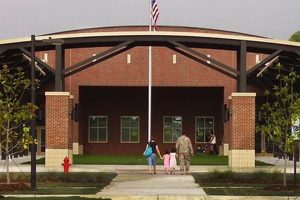Structured daily timelines for students in grades K-5 typically outline the allocation of time for various subjects, activities, and transitions throughout the school day. These frameworks can range from traditional models with distinct periods for each subject to more flexible approaches incorporating interdisciplinary learning and extended blocks for focused study. A sample timetable might include designated times for language arts, mathematics, science, social studies, art, music, physical education, lunch, and recess. Variations exist to accommodate different educational philosophies, grade levels, and specific student needs.
Well-designed timetables provide a predictable and organized learning environment, fostering student engagement and academic progress. A balanced schedule ensures sufficient time for core subjects while integrating opportunities for creativity, physical activity, and social-emotional development. Historically, structured schedules emerged with the rise of compulsory education and the need to manage larger groups of students efficiently. The evolution of pedagogical approaches continues to influence how time is allocated within the school day to maximize learning outcomes.
Further exploration of this topic will delve into specific scheduling models, the factors influencing their design, and the impact of various timetabling strategies on student achievement and well-being. This will include an examination of best practices, emerging trends, and considerations for diverse learning styles and individual student needs.
Tips for Effective Elementary School Scheduling
Creating effective schedules is crucial for maximizing learning and student well-being in elementary school settings. The following tips offer guidance for developing and implementing successful timetables.
Tip 1: Prioritize Core Subjects: Adequate time should be allocated for core subjects like reading, writing, and mathematics. These foundational skills require consistent, focused instruction.
Tip 2: Incorporate Movement and Breaks: Regular breaks and physical activity are essential for maintaining student focus and promoting physical health. Recess and short movement breaks throughout the day can enhance concentration.
Tip 3: Balance Structure and Flexibility: While a structured schedule provides predictability, flexibility is important to accommodate unexpected events and cater to individual learning needs. Building in buffer time allows for adjustments.
Tip 4: Consider Developmental Needs: Younger students generally benefit from shorter periods of focused instruction interspersed with more frequent breaks and activity changes. Attention spans lengthen as students progress through the grades.
Tip 5: Integrate Arts and Enrichment: Art, music, and other enrichment activities contribute to well-rounded development and offer opportunities for creative expression. These subjects should be incorporated into the schedule regularly.
Tip 6: Collaborate with Stakeholders: Input from teachers, administrators, parents, and even students can contribute to a schedule that meets the diverse needs of the school community. Open communication ensures buy-in and support.
Tip 7: Regularly Evaluate and Adjust: Schedules should be reviewed and adjusted periodically to ensure they continue to serve their intended purpose effectively. Gathering feedback and analyzing student performance data can inform necessary modifications.
Effective scheduling significantly contributes to a positive and productive learning environment. By incorporating these tips, schools can create timetables that optimize student engagement, academic progress, and overall well-being.
Through careful planning and ongoing evaluation, educational institutions can create dynamic and supportive learning environments tailored to the specific needs of their elementary school students.
1. Grade-Level Variations
Developmental appropriateness forms the cornerstone of effective elementary school scheduling. Grade-level variations in schedules reflect the evolving cognitive, social, and emotional needs of students as they progress through their elementary years. Examining these variations provides crucial insight into how schedules can best support student learning and well-being at each stage.
- Attention Span and Focus:
Younger students typically have shorter attention spans, requiring more frequent transitions and shorter periods of focused instruction. A first-grade schedule might incorporate numerous short activities interspersed with movement breaks. In contrast, older elementary students can sustain attention for longer durations, allowing for more extended periods dedicated to specific subjects or project-based learning.
- Skill Development and Complexity:
As students progress through the grades, the complexity and depth of the curriculum increases. Early elementary schedules may emphasize foundational skills in literacy and numeracy, while later grades introduce more complex concepts and interdisciplinary connections. This progression influences the allocation of time to different subjects and the types of learning activities employed.
- Independence and Self-Regulation:
Older elementary students typically demonstrate greater independence and self-regulation skills. Schedules for these grades might incorporate more opportunities for independent work, choice activities, and student-led learning. Younger students may require more direct guidance and structured routines.
- Social and Emotional Learning:
Social and emotional learning (SEL) remains a crucial aspect of development throughout elementary school. While SEL is integrated into all grade levels, the specific approaches and time allocation may vary. Younger grades might emphasize foundational skills like recognizing emotions and building relationships, while older grades focus on more nuanced concepts like conflict resolution and empathy.
Understanding these grade-level variations is fundamental to developing schedules that effectively support student growth and development. By aligning schedules with the specific needs of each grade, schools can create learning environments that foster engagement, academic progress, and social-emotional well-being. This tailored approach recognizes that a “one-size-fits-all” schedule is unlikely to meet the diverse needs of a dynamic elementary school population.
2. Subject allocation
Subject allocation within elementary school schedules significantly influences the balance and breadth of a student’s educational experience. Effective allocation ensures adequate time for core subjects like language arts and mathematics while integrating essential areas such as science, social studies, arts, and physical education. The process requires careful consideration of curriculum requirements, developmental needs, and available instructional time. For example, a school prioritizing literacy might dedicate a larger portion of the morning schedule to reading and writing instruction, while another school might emphasize a STEM-focused approach, allocating more time to science and mathematics. The interplay between subject allocation and scheduling models produces diverse timetable structures, each designed to achieve specific educational goals.
Practical considerations play a vital role in subject allocation. Factors such as teacher expertise, resource availability, and state mandates influence how instructional time is distributed. Schools might adopt block scheduling, assigning longer periods to specific subjects, or implement a more traditional approach with shorter, distinct periods for each subject. Real-world examples demonstrate this variety: some schools prioritize daily physical education, while others concentrate physical activity into specific days. Similarly, art and music instruction might be integrated into classroom activities or provided as specialized classes within the weekly schedule. Careful subject allocation directly impacts student access to a well-rounded curriculum and contributes to their overall academic development.
Effective subject allocation requires ongoing evaluation and adjustment. Analyzing student performance data, gathering teacher feedback, and considering current educational research inform decisions about instructional time prioritization. Challenges such as limited resources or competing curricular demands require strategic allocation to ensure all students receive a balanced and enriching educational experience. Understanding the connection between subject allocation and scheduling empowers educators to create learning environments that optimize student engagement and achievement.
3. Recess and Breaks
Recess and breaks are integral components of effective elementary school schedules, serving crucial roles in student well-being and academic performance. These periods of unstructured play and rest offer children opportunities for physical activity, social interaction, and cognitive restoration. Their strategic placement within the daily schedule directly influences student engagement and learning outcomes. For example, a well-timed recess after a period of intensive academic instruction can improve focus and reduce restlessness in subsequent lessons. Conversely, insufficient or poorly scheduled breaks can contribute to decreased concentration and increased disruptive behavior.
The importance of recess and breaks extends beyond simple respite. Recess provides opportunities for developing social skills, negotiating peer interactions, and engaging in imaginative play. These unstructured activities contribute significantly to children’s social-emotional development and can enhance their ability to navigate complex social situations. Short breaks throughout the day, even just a few minutes, allow students to stretch, move, and refocus their attention, promoting physical health and improving cognitive function. Studies have shown a correlation between regular physical activity and improved academic performance, further supporting the inclusion of movement breaks within the school day. Differing approaches to scheduling these periods reflect varying educational philosophies and practical constraints. Some schools implement longer recess periods combined with shorter classroom breaks, while others opt for more frequent, shorter breaks throughout the day. The effectiveness of each approach depends on factors such as student age, developmental needs, and overall school environment.
Integrating recess and breaks effectively requires careful consideration of their placement within the daily schedule, their duration, and the available resources for supervising and facilitating these periods. Challenges such as limited outdoor space or inclement weather necessitate creative solutions, such as indoor movement activities or alternative break options. Addressing these challenges underscores the importance of recognizing recess and breaks not as ancillary activities but as essential components of a well-rounded elementary education. Their strategic implementation contributes significantly to creating a positive and productive learning environment that supports both academic achievement and student well-being.
4. Lunch periods
Lunch periods represent a crucial element within elementary school schedules, impacting not only students’ nutritional intake but also their social-emotional development and overall learning experience. Their placement and duration within the daily schedule influence classroom management, student behavior, and the effectiveness of afternoon instruction. A well-structured lunch period provides adequate time for students to consume a nutritious meal, socialize with peers, and engage in supervised activities that promote physical activity and relaxation. Conversely, insufficient lunch periods or poorly managed cafeteria environments can contribute to disruptive behavior, decreased concentration, and reduced academic performance in the afternoon. For example, a rushed lunch period might leave students feeling hungry and restless, impacting their ability to focus during subsequent lessons. Alternatively, a lengthy lunch period without structured activities could lead to boredom and increased opportunities for conflict.
Several factors influence the design and implementation of lunch periods within elementary school schedules. School size, available facilities, and staffing limitations often dictate the logistics of lunch service and supervision. Staggered lunch schedules, common in larger schools, allow for efficient use of cafeteria space but may disrupt classroom routines. Open lunch periods, allowing students to choose their seating and socialize freely, promote social interaction but require careful monitoring to ensure appropriate behavior. Practical considerations such as food allergies, dietary restrictions, and cultural preferences further influence meal planning and cafeteria management. Understanding the interplay of these factors is essential for developing lunch periods that effectively support student needs and contribute to a positive school environment. Real-world examples illustrate the diverse approaches schools take to address these challenges. Some schools partner with community organizations to offer nutrition education programs during lunch, while others utilize peer mediators to resolve conflicts and promote positive social interactions in the cafeteria.
Effective lunch period planning requires careful consideration of student needs, logistical constraints, and the overall educational goals of the school. A balanced approach addresses nutritional requirements, social-emotional development, and the practical realities of managing large groups of children. Addressing challenges related to limited resources, varying student needs, and potential behavioral issues is essential for creating lunch periods that contribute positively to the overall school experience. Well-designed lunch periods serve as a valuable component of a comprehensive elementary school schedule, supporting student well-being and promoting academic success.
5. Special Activities
Special activities, encompassing assemblies, field trips, guest speakers, and school-wide events, represent vital elements within elementary school schedules. These activities extend learning beyond the traditional classroom, enriching the curriculum and fostering student engagement. Their strategic inclusion within the timetable influences the overall educational experience, contributing to both academic and social-emotional development. For instance, a school-wide science fair provides students with opportunities to apply scientific principles in a practical context, fostering critical thinking and problem-solving skills. A visiting author’s presentation can spark a love of reading and inspire creative writing endeavors. The placement and frequency of these activities require careful consideration to maximize their impact while minimizing disruption to regular instruction. Overly frequent or poorly timed special activities can fragment instructional time and impede academic progress. Conversely, their absence can limit exposure to enriching experiences that broaden students’ horizons and foster a sense of community.
Several factors influence the selection and scheduling of special activities. School budgets, community resources, and administrative priorities play significant roles in determining the types and frequency of these events. Assemblies focusing on character education or cultural awareness can promote positive school climate and social-emotional learning. Field trips to museums or historical sites provide hands-on learning experiences that connect classroom content to real-world contexts. Practical considerations, such as transportation logistics, chaperone availability, and student safety protocols, influence the feasibility and timing of these activities. Real-world examples illustrate the diverse approaches schools take to incorporating special activities into their schedules. Some schools dedicate specific days or blocks of time for these events, while others integrate them into existing curriculum units. The effectiveness of each approach depends on the specific goals of the activity and the overall structure of the school schedule.
Successful integration of special activities requires a balance between enriching the curriculum and maintaining a consistent learning environment. Addressing potential challenges, such as scheduling conflicts or limited resources, is essential for maximizing the benefits of these activities. Collaboration between teachers, administrators, and community partners can enhance the quality and relevance of these experiences. Ultimately, well-planned special activities serve as valuable extensions of the classroom, fostering student engagement, promoting holistic development, and creating a vibrant school community. Their strategic placement within the elementary school schedule contributes significantly to a well-rounded and enriching educational experience.
6. Sample Templates
Sample templates provide concrete examples of how various scheduling components can be integrated into a functional timetable for elementary schools. These templates serve as practical tools for educators and administrators, offering a starting point for developing schedules tailored to specific school contexts. Examining these templates illuminates the interplay between different scheduling models, grade-level variations, and the allocation of time for core subjects, special activities, and essential breaks. Analysis of sample templates provides valuable insights into the practical application of scheduling principles and their impact on student learning experiences.
- Traditional Schedules:
Traditional schedules typically feature distinct periods allocated for each subject, following a consistent daily or weekly structure. This model offers predictability and facilitates classroom management. A sample template might show a daily schedule with set times for language arts, math, science, social studies, and other subjects. Real-world examples include schools utilizing a six-period day with 45-minute classes. This models implications include a structured learning environment but potentially limited flexibility for interdisciplinary projects or extended learning activities.
- Block Scheduling:
Block scheduling utilizes longer time blocks for specific subjects, allowing for in-depth exploration and project-based learning. Sample templates might demonstrate a rotating schedule with alternating days for different subject combinations. Real-world examples include schools implementing 90-minute blocks for language arts and mathematics on alternating days. This models implications include deeper dives into subjects but potentially fewer opportunities to cover a wide range of topics within a given week.
- Flexible/Integrated Schedules:
Flexible or integrated schedules incorporate varied time blocks and interdisciplinary connections, allowing for greater adaptability and personalized learning. Sample templates might demonstrate a schedule with core subject blocks interspersed with flexible time for enrichment activities, small group instruction, or project work. Real-world examples include schools utilizing a project-based learning approach, integrating multiple subjects within a thematic unit. This model’s implications include increased opportunities for personalized learning and interdisciplinary connections but potentially greater demands on teacher planning and coordination.
- Specialty Area Rotations:
Templates for specialty area rotations outline the scheduling of subjects like art, music, physical education, and library time. These rotations ensure that students receive consistent exposure to these enrichment areas. Real-world examples include schools using a weekly rotation, where each class attends a different specialty area each day. This models implications include dedicated time for essential enrichment activities but potentially require complex coordination to ensure equitable access for all students.
By examining and adapting these sample templates, educators can develop schedules that align with their school’s specific needs and educational philosophy. Comparing different models and considering the practical implications of each approach allows for informed decision-making. Ultimately, the goal is to create a schedule that optimizes student learning, promotes well-being, and provides a balanced and enriching educational experience. Analyzing real-world examples within these template frameworks further clarifies the connection between scheduling structures and educational outcomes in elementary school settings.
Frequently Asked Questions about Elementary School Schedules
This section addresses common inquiries regarding the development, implementation, and impact of elementary school schedules. Understanding these frequently asked questions provides valuable insights for educators, administrators, and parents seeking to create effective learning environments.
Question 1: How do elementary school schedules differ across grade levels?
Schedules typically adapt to developmental needs. Younger students benefit from shorter, more frequent activity changes, while older students can manage longer periods of focused instruction.
Question 2: What is the role of recess and breaks in elementary school schedules?
Recess and breaks provide crucial opportunities for physical activity, social interaction, and cognitive rest, contributing to student well-being and improved focus in academic settings.
Question 3: How do schools accommodate special activities like assemblies and field trips within the schedule?
Special activities are often integrated strategically to minimize disruption to core instruction. Some schools dedicate specific days or blocks of time for these events, while others weave them into existing curriculum units.
Question 4: What are the different scheduling models commonly used in elementary schools?
Common models include traditional schedules with distinct periods for each subject, block scheduling with longer time blocks for in-depth study, and flexible/integrated schedules incorporating varied time blocks and interdisciplinary connections.
Question 5: How can parents contribute to the effectiveness of their child’s school schedule?
Open communication with teachers and administrators regarding a child’s individual needs and learning style can contribute to a more supportive and effective learning experience. Consistent routines at home can further reinforce the structure provided by the school schedule.
Question 6: How do schools adapt schedules to accommodate students with diverse learning needs?
Schools often implement individualized education programs (IEPs) and other support systems to adapt schedules and instructional approaches to meet the specific needs of students with learning differences.
Effective scheduling requires thoughtful consideration of student needs, curriculum requirements, and practical constraints. Understanding these FAQs provides a foundation for developing schedules that support student success and well-being.
The subsequent section will explore real-world case studies illustrating effective scheduling practices in diverse elementary school settings.
Conclusion
Examination of various elementary school schedule examples reveals the critical role of structured time in fostering effective learning environments. Key factors such as developmental appropriateness, subject allocation, integration of special activities, and provision for essential breaks contribute significantly to student engagement and academic success. Diverse scheduling models, ranging from traditional period-based structures to more flexible integrated approaches, offer adaptable frameworks for meeting the unique needs of individual schools and student populations. Analysis of these models highlights the importance of aligning schedules with educational philosophies, curriculum goals, and available resources.
Effective scheduling requires ongoing evaluation, adaptation, and collaboration among educators, administrators, and families. A well-designed schedule provides the foundation for a positive and productive learning experience, maximizing student potential and fostering a sense of order and purpose within the school community. Continued exploration and refinement of scheduling practices remain essential for optimizing educational outcomes and creating supportive learning environments for all elementary school students. This ongoing process underscores the enduring significance of structured time as a fundamental element in elementary education.







